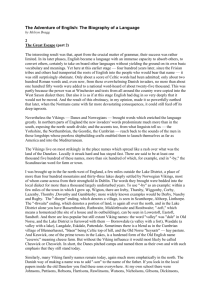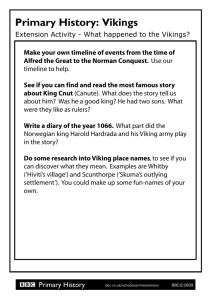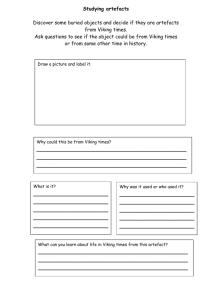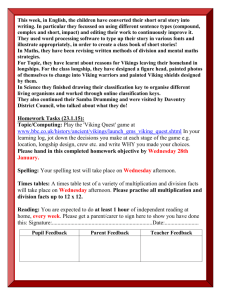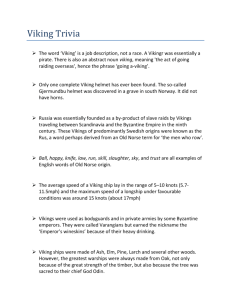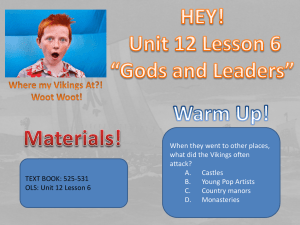History of the Viking Settlement in England
advertisement
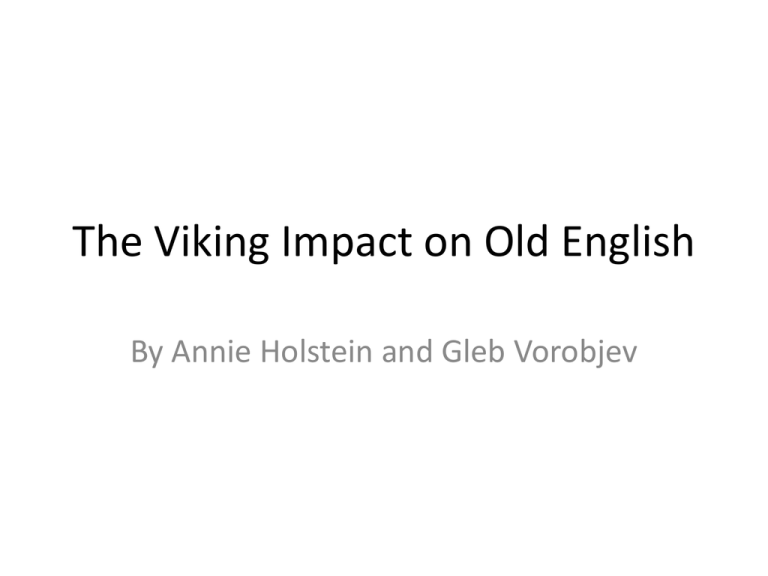
The Viking Impact on Old English By Annie Holstein and Gleb Vorobjev The Vikings: • • • • Explorers, warriors and sailors from Scandinavia (Denmark, Norway and Sweden) Excellent sailors and would travel great distances by sea to attack and colonize foreign nations. They were also skilled at ship building, their ships were well crafted and powerful. One well known example were the Longships, also known as longboats. – – They were narrow and light so they could travel great distances. Without a deep hull they were able to move quickly through varying and it also allowed the Vikings to dock right on the beach. – They could reverse direction quickly without having to turn around. – They had oars along the sides of the boat so the boat could either be rowed or sailed. – These were the boats that transported the Viking troops; they were used in battle. • The Vikings didn’t have a strong literary tradition and much of their history went unrecorded. depths of water, n’t usually History of the Viking Presence in England 787 – Viking Raids, persistent attacks on the Anglo-Saxons. c.850- Viking Settlement began 886- The Treaty of Danelaw 991- Battle of Maldon, Viking victory. Gained more land and won power for the next 25 years. 1066- Norman Conquest, the overthrow of the Vikings. c1200- Recognized start of Middle English. Why was Old Norse so readily absorbed… • Pre-Existing closeness: Both Old Norse and Old English are Germanic languages. This relation between the two languages allowed an easier mixing of the languages, an inter-dialectal convergence. • Lack of writing: The general Viking and Anglo-Saxon cultures were non literary. Their communications were mainly spoken allowing the two languages to more easily merge. • The Norman Conquest: The Norman invasion brought literacy to a population with a mainly oral tradition. The hybridized language that was now in existence, Middle English, was then further cemented by its new documented form. More reasons… • Similar Pronouns: Born from the same Germanic language, only diverging 200 years prior, ON and OE pronouns were very similar, especially personal, demonstrative and sometimes auxiliary pronouns. This similarity allowed for a smooth combination. • Simplification: The similarity between the dialects allowed interlanguage communication. A creoloid language was formed from the everyday interactions. The inevitable simplification of this hybridized language more securely mixed the two. • Complete Absorption: With the complete absorption of ON words came the beginning of the Middle English language. Viking Influence on Names Personal Names • The personal names of English families reflected the Old Norse influence. • Names such as Davidson and Henderson began to appear. These surnames were highly concentrated in the North. Town Names • The Viking presence in England, mainly in the Danelaw area, many of the towns and regions adopted Old Norse names by 12th Century. Here are some examples of name shifts from Old English. Many of the current names still reflect that transition to Old Norse names. Original Old English Town Name New Name Under Old Norse Influence Current Name Queneberie Quenbia Quenby Wardhille Warthehill Warthill Schorton Scorton Scorton Walmesgar Walmesgate Walmsgate Pronouns • In Old English prior to the arrival of the Vikings, third person plural pronouns all began with the letter “h”. • They were less distinct from themselves and their singular counterparts leading to confusion in speech. • The introduction of Old Norse which used the equivalent of they, them and their, but otherwise similar pronouns, replaced Old English’s previous 3rd person plural pronouns completely by the 15th century. • The adaptation of the 3rd person plural pronouns functioned as one of the many changes from Old English into Middle English. The following table represents the pronoun changes I We You (SG) You (PL) he she it they we2 you2 Nom ic we: þu: ge: he: he:o hit hi:/he:o they wit git Gen mi:n u:re þi:n e:ower his hire his hira their unce r incer Dat me: u:s þe: e:ow him hi: him him unc inc unc inc them Acc me: u:s þe: e:ow hine hi: hit hi:/he:o them Adopting Words and Sounds • Old Norse infiltrated the Anglo-Saxon language not just grammatically or in the names of towns and people, but also in the vocabulary and in pronunciations. • Previously, in OE “c” made a soft “ch” sound, like church. Also, “sc” made a soft “sh” sound ship. • However, with the presence of ON, the hard “k” sound was introduced. OE/ON Vocabulary Exchange • Many words from Old Norse became a part of the Old English language, as it transformed into Middle English, though not always replacing its OE counterpart. Sometimes both forms continued to be used. Old English Modern English Old Norse scearp sharp skarpr scell shell skell sceo sky sky ditch ditch/dike dike
